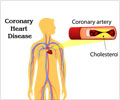Researchers have developed a quick and easy artificial intelligence approach to successfully calculate a patient's heart attack risk with respect to many lifestyle factors.
Researchers have developed a quick and easy artificial intelligence approach to successfully calculate a patient's heart attack risk with respect to many lifestyle factors.
Named online analytical processing (OLAP), the approach makes it possible for physicians to just use their system to provide patients with a personal risk factor and so advise on lifestyle changes or medication to lower their risk.It is well known that lifestyle factors including depression, education, smoking, diet, and obesity, play a part in the risk of cardiovascular disease.
But, epidemiologists who study how health risks vary through populations have not found a way to extrapolate from such broad studies to individual risk levels.
Now, Hara Kostakis of the TEI Piraeus Research Centre, in Methonis, Greece, and colleagues have investigated patterns of cardiovascular risk factors in a large population by collecting data for almost 1000 patients enrolled in the CARDIO 2000 study who had been hospitalised with the first symptoms of ACS, acute coronary syndrome.
After recording details of body mass index, family history, physical activity, high blood pressure, high cholesterol, and diabetes, they matched the data against healthy individuals as a scientific control.
And instead of using conventional methods for analysing statistics, the researchers borrowed an approach from the computer science field of artificial intelligence, OLAP, which was developed in the early 1990s and was exploited primarily in industrial and commercial applications, for financial and marketing analysis.
Advertisement
Researchers at the University of Patras have already adapted this system to accommodate the risk factors of heart disease.
Advertisement
But they have claimed that their approach works much more quickly than conventional statistical analysis, reveals hidden risk factors and associations and makes none of the assumptions of standard approaches to assessing risk of heart attack.
"Due to the ease of use of the methodology, a physician has the advantage of easily identifying high-risk patients by simply entering their personal data in the model," The Science Daily quoted the researchers as saying.
An thus, they can advise their patient on lifestyle and psychological. They can also prescribe more appropriate medication depending on the specific risk factors.
Source-ANI
SRM














